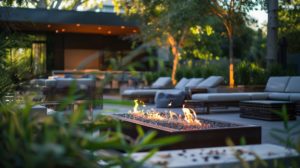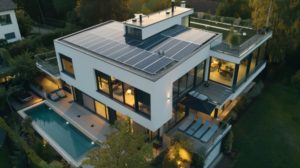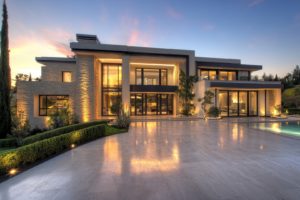
Your Top 10 Architectural Questions Answered: A Guide to Creating Your Dream Home
The journey from an inspired concept to a beautifully realized home is filled with important decisions. As you contemplate bringing your vision to life in Johannesburg’s leafy northern suburbs or perhaps on a stunning plot in Sandton, certain questions inevitably arise. At CF Architects, we’ve gathered the most frequently asked questions potential clients search for when beginning their architectural journey. This guide provides thoughtful answers to help navigate the exciting process of creating exceptional living spaces in South Africa’s distinctive residential landscape.

1. Do I Need an Architect for My Home Project?
Many homeowners wonder if their project truly requires architectural expertise. While minor renovations might not necessitate professional architectural services, any significant structural changes, additions, or new builds benefit immensely from an architect’s vision and technical knowledge.
Architecture transcends simple building design—it transforms abstract ideas into concrete reality while addressing complex spatial, aesthetic, and practical challenges. In Johannesburg’s diverse neighborhoods, from established areas like Bryanston to newer developments in Fourways, architects bring valuable understanding of local conditions, building regulations, and design possibilities that enhance both lifestyle and property value.
For luxury homes, an architect’s contribution becomes even more significant. Beyond creating beautiful spaces, architects integrate sophisticated systems invisibly, solve complex site challenges, and ensure that every element of your home works harmoniously. They transform constraints into opportunities, creating homes that feel both personalized and timeless. The question isn’t whether you need an architect, but rather what level of architectural service will best support your vision.
2. What's the Difference Between an Architect and a Draftsman?
This distinction becomes particularly important when considering upscale residential projects across Johannesburg’s northern reaches. Architects undergo extensive education and professional registration, equipping them with comprehensive design capabilities, technical knowledge, and project management skills. In South Africa, qualified architects must register with the South African Council for the Architectural Profession (SACAP), ensuring they meet rigorous professional standards.
A draftsman typically creates technical drawings but lacks the holistic design approach and problem-solving expertise that characterizes architectural work. While both may produce building plans, architects approach your home as a complete environment rather than simply a structure. Their training encompasses spatial psychology, environmental considerations, construction methodologies, and aesthetic principles that together create meaningful living experiences.
In the context of high-end residential work in areas like Sandton and Bryanston, an architect’s broader perspective delivers substantial value. They consider how light moves through spaces throughout the day, how rooms flow into one another, how the building responds to its site, and how technical systems integrate seamlessly with the design—considerations that transform houses into homes that genuinely enhance daily life.
3. How Much Does an Architect Cost in South Africa?
The cost of architectural services consistently ranks among the most searched topics for potential clients. Architectural fees in South Africa typically range between 8-12% of construction costs for high-end residential projects, with several factors influencing this percentage. These include project complexity, site challenges, level of detail required, and the extent of architectural involvement during construction.
Most established firms in Johannesburg’s northern suburbs structure their fees according to the stages outlined by SACAP, which include inception, concept design, design development, documentation, and construction administration. Some architects charge hourly rates for initial consultations, while others include these in their overall fee structure once engaged.
Rather than viewing architectural fees as an expense, savvy homeowners recognize them as an investment. Quality architectural design significantly enhances property value, with well-designed homes in areas like Sandton and Bryanston often commanding premium prices in the real estate market. More importantly, architects prevent costly construction mistakes, optimize spaces for efficiency and flow, incorporate sustainable elements that reduce ongoing operational costs, and create designs that stand the test of time, both structurally and aesthetically.
4. How Do I Find the Right Architect Near Me?
Finding the right architect for your project involves more than simply searching “architects near me.” The relationship between homeowner and architect is collaborative and often extends over many months, making compatibility and communication essential. Begin by researching architects who specialize in residential projects similar to your vision. In South Africa’s diverse architectural landscape, some firms excel at contemporary minimalism while others may specialize in traditional designs or modern African interpretations.
When evaluating portfolios, look beyond aesthetics to consider how different architects solve spatial problems. Has the architect created successful solutions for sloped sites common in Highveld areas? Do their designs demonstrate thoughtful responses to the intense Johannesburg sunlight? Are their security solutions elegantly integrated rather than visually obtrusive?
Initial consultations provide crucial insight into communication styles and design philosophy. The right architect will listen attentively to your requirements while also challenging your thinking and introducing possibilities you hadn’t considered. For luxury homes in exclusive estates across Johannesburg’s northern suburbs, finding an architect familiar with specific estate guidelines can significantly streamline the process.
At CF Architects, we believe that the best architectural partnerships begin with careful listening and clear communication. Our Bryanston studio serves as a creative laboratory where your vision combines with our expertise to create living spaces that exceed expectations.
5. How Long Does the Architectural Design Process Take?
Understanding the architectural design process helps set realistic expectations for your project timeline. From initial concept to completed construction, a custom home in South Africa typically takes 18-24 months, with approximately 6-8 months dedicated to the design and documentation phases before construction begins.
The process begins with the inception phase, where your architect gathers information about your needs, budget, site conditions, and aesthetic preferences. This foundation-setting stage is followed by concept design, where initial spatial ideas and approaches are explored. During design development, these concepts are refined into detailed plans with material selections, specific layouts, and technical considerations.
Documentation follows, with the creation of comprehensive drawings for council submission and construction purposes. In areas like Sandton and Fourways, council approval typically takes 3-4 months for residential projects, though this can vary based on complexity and compliance. Throughout construction, your architect provides essential oversight to ensure the built result aligns with the approved design.
For renovations or smaller projects, the timeline compresses accordingly, but the sequential nature of the process remains similar. Experienced architects understand the importance of managing time expectations and planning for the inevitable adjustments that occur throughout the design journey.
6. What Should I Prepare Before Meeting With an Architect?
Preparing for your initial architectural consultation significantly enhances the productivity of early discussions. Bringing site information (if available), inspirational images, rough budget parameters, and a clear articulation of how you want to live in your space all help architects understand your vision.
Create a prioritized list of your requirements, distinguishing between essential needs and desirable features. This helps establish parameters when design decisions involve trade-offs. Consider how you currently use your living spaces and what works well or poorly in your current home. Reflect on your daily routines, entertainment patterns, and how these might evolve in the future.
Gathering examples of architectural styles, materials, or spatial arrangements that appeal to you helps communicate your aesthetic preferences. These might include magazine clippings, digital images, or references to buildings you’ve experienced firsthand. Equally valuable is identifying elements you specifically don’t want in your home.
However, also bring an open mind; the best architectural solutions often emerge from collaborative dialogue rather than rigid preconceptions. Experienced architects may suggest approaches you haven’t considered that better achieve your underlying goals. At CF Architects, we value this preparatory work as the foundation for successful design partnerships with our clients throughout Johannesburg’s northern suburbs.
7. Can Architects Help With Planning Permission and Building Regulations?
One of the most valuable services architects provide is navigating the complex regulatory environment. In Johannesburg and surrounding areas, obtaining council approval involves multiple departments and requirements, including zoning compliance, building line restrictions, coverage limitations, and height restrictions. Architects familiar with local regulations can design with these parameters in mind, reducing the risk of costly revisions.
For homes in established estates in areas like Waterfall or Steyn City, an additional layer of aesthetic guidelines often applies. These can include restrictions on materials, roof pitches, boundary treatments, and overall architectural expression. Experienced architects understand how to work creatively within these constraints while still achieving distinctive designs.
The approval process typically includes town planning approvals, building plan approvals, and sometimes environmental and heritage considerations. Architects coordinate with various consultants including structural engineers, electrical engineers, and in some cases, landscape architects to ensure comprehensive compliance while maintaining design integrity.
Rather than seeing regulations as limitations, skilled architects view them as design parameters that can actually enhance creativity. Understanding local guidelines thoroughly allows for innovative solutions that satisfy both regulatory requirements and client aspirations—a balancing act that requires professional expertise.
8. What Architectural Style Is Best for My Home?
While “what architectural style is best for my home?” ranks among frequently searched questions, the answer depends on various factors including site context, personal preference, and functional requirements. Contemporary South African residential architecture has evolved beyond rigid stylistic categories to embrace a more nuanced approach that responds to climate, context, and culture.
Modern minimalism continues to influence luxury homes across Johannesburg, characterized by clean lines, large expanses of glass, and a restrained material palette. This aesthetic allows the surrounding landscape to become an integral part of the design while creating serene, uncluttered living environments.
African modernism has gained significant traction, reinterpreting traditional elements through a contemporary lens. This approach often incorporates deep overhangs reminiscent of traditional structures, carefully considered natural ventilation, locally sourced materials, and spatial arrangements that respect cultural patterns of living while embracing modern conveniences.
Transitional designs bridge contemporary and traditional aesthetics, combining modern spatial planning with warmer materials and familiar forms. This approach remains popular in established neighborhoods like Bryanston, where context often suggests a dialogue between old and new rather than architectural disruption.
The most successful residential designs transcend stylistic labels to create authentic responses to site, client, and context. Rather than following trends, they establish a timeless quality through proportional harmony, material integrity, and spatial richness—principles that remain constant regardless of stylistic expression.
9. How Do Architects Address South African-Specific Concerns?
South African homeowners have unique concerns that influence architectural decisions. Security considerations rank high among these, with clients frequently searching for architects who can create safe homes without fortress-like aesthetics. Contemporary approaches integrate security seamlessly through thoughtful space planning, strategic placement of openings, careful landscaping, and intelligent technology implementation.
Energy solutions have become increasingly important with ongoing load shedding challenges. Architects now routinely incorporate backup power systems, energy-efficient design principles, and alternative energy sources into high-end residential designs across Johannesburg’s northern suburbs. Similarly, water conservation features such as rainwater harvesting systems, water-efficient fixtures, and drought-resistant landscaping have become standard considerations in architectural planning.
The varied topography found throughout Johannesburg presents both challenges and opportunities. Sloped sites, common in many northern suburbs, require specialized design approaches but often reward with spectacular views and dramatic architectural possibilities. Experienced architects transform these challenging conditions into distinctive features that characterize exceptional homes.
Indoor-outdoor living remains a quintessential aspect of South African residential architecture. The benevolent climate allows for blurred boundaries between internal and external spaces, with covered patios, courtyards, and pool areas functioning as essential extensions of the living environment. Contemporary designs often feature expansive glass openings, deep overhangs for sun protection, and carefully considered orientation to maximize natural light while minimizing heat gain.
10. What Value Does an Architect Add to My Project?
Perhaps the most important question centers on the value architectural services bring to residential projects. Beyond creating beautiful spaces, architects serve as advocates for their clients throughout the design and construction process. Their expertise prevents costly mistakes, ensures compliance with regulations, and helps navigate the complexities of building procurement.
Good architecture adds significant financial value to properties. Well-designed homes in areas like Sandton, Bryanston, and Fourways consistently command higher resale values and sell more quickly than comparable properties without architectural input. The optimization of space, quality of light, thoughtful material selections, and overall coherence that characterize architect-designed homes translate directly into market value.
Equally important is the experiential value created through thoughtful design. Architects create spaces that enhance daily living experiences, from the quality of morning light in a breakfast area to the seamless flow between indoor and outdoor spaces for entertaining. These qualities contribute to wellbeing and lifestyle in ways that transcend simple functionality.
Finally, architects bring a level of creativity and problem-solving that transforms ordinary buildings into extraordinary homes. They see possibilities where others see constraints, creating unique living environments that respond precisely to their clients’ needs while also contributing positively to the broader built environment.
Creating Your Architectural Journey
At CF Architects, we believe that creating an exceptional home begins with understanding the architectural process and establishing a strong client-architect relationship. Whether you’re building in Sandton, renovating in Fourways, or developing in Bryanston, architectural expertise transforms aspirations into living environments that enhance daily life and create lasting value.
The questions addressed in this article reflect common concerns at the beginning of the architectural journey, but each project unfolds uniquely. The most successful outcomes emerge from open communication, mutual trust, and a shared commitment to quality. As you consider your own architectural project, we invite you to explore how our expertise might contribute to realizing your vision for exceptional living spaces.
CF Architects specializes in high-end residential architecture across Johannesburg’s northern suburbs, bringing thoughtful design solutions to each unique project. For more information about our services or to arrange an initial consultation, please visit our website or contact our Bryanston studio.
Most Recent Articles

Reimagining Home: The Art and Science of Open Plan Living
In the sun-drenched landscapes of Johannesburg’s northern suburbs, a quiet revolution has been transforming residential architecture for the past decade.

Transform Your Home: Designing Ultimate Outdoor Entertainment Spaces
In Johannesburg’s sun-blessed climate, outdoor living transcends luxury to become an essential component of modern home design. As Highveld homeowners

Designing for Tomorrow: Smart Energy Solutions for South African Homes
In a country where power outages have become part of daily life, creating energy-independent homes isn’t just about sustainability—it’s about

Designing Timeless Modern Family Homes: Creating Enduring Spaces for South African Living
In Johannesburg’s ever-evolving residential landscape, the quest for a home that balances contemporary elegance with lasting appeal presents both challenges
I'd Like More Information
CHOOSE A PLAN THATS RIGHT FOR YOU
Don't miss out on our latest news and offers - subscribe to our newsletter!
No Obligation, Complimentary Meeting.
